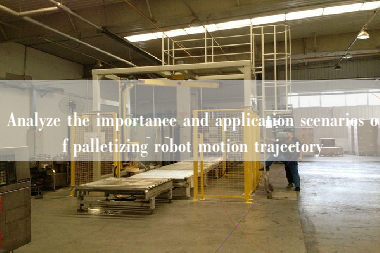List of contents of this article
- Importance of motion trajectory analysis of palletizing robot
- application scenarios
- How to analyze the movement trajectory of a palletizing robot?
- conclusion
A palletizing robot is an automated device used to stack boxes, bags, bottles and other items together to form a neat stack. During this process, the robot needs to move according to a certain trajectory to ensure that items can be stacked correctly together.
The motion trajectory of a palletizing robot refers to the path taken by the robot when performing the stacking task. This path is calculated by the robot control system based on the task requirements and the robot’s own characteristics. It determines the movement mode and speed of the robot when stacking objects, and has an important impact on the robot’s motion control and task completion efficiency.
Importance of motion trajectory analysis of palletizing robot
The motion trajectory analysis of a palletizing robot has an important impact on the robot’s motion control and task completion efficiency. Here are some of its important functions:

1. Improve the accuracy of robot motion control
A palletizing robot needs to complete the task of stacking objects in a limited space, so its motion trajectory needs to be accurately controlled. By analyzing the robot’s motion trajectory, the robot’s motion path and speed can be determined to ensure that the robot can accurately complete the task.
2. Optimize the robot’s motion speed
The movement speed of a palletizing robot has an important impact on the efficiency of task completion. By analyzing the robot’s motion trajectory, the optimal motion speed of the robot can be determined to ensure that the robot can complete the task in the shortest time.
3. Improve the productivity of robots
The motion trajectory analysis of the palletizing robot can help the robot complete tasks automatically and intelligently. Through the analysis of the robot’s motion trajectory, the optimal motion path and speed of the robot can be determined to ensure that the robot can complete the task in the shortest time and improve the robot’s work efficiency.
application scenarios
The movement trajectory analysis of palletizing robots is widely used in the following aspects:
1. warehousing logistics
In the field of warehousing and logistics, palletizing robots are an important automated equipment. Through the analysis of the robot’s motion trajectory, the optimal motion path and speed of the robot can be determined to improve the efficiency and accuracy of warehousing and logistics.
2. manufacturing
In the field of production and manufacturing, palletizing robots are also widely used. By analyzing the robot’s motion trajectory, the optimal motion path and speed of the robot can be determined to improve the efficiency and accuracy of production and manufacturing.
3. food processing
In the field of food processing, palletizing robots are also widely used. By analyzing the robot’s motion trajectory, the optimal motion path and speed of the robot can be determined to improve the efficiency and accuracy of food processing.
How to analyze the movement trajectory of a palletizing robot?
Analyzing the movement trajectory of the palletizing robot requires the following steps:
1. Determine mission requirements
The first task requirements need to be determined, including the size, quantity and stacking method of stacked items. This information will serve as the basis for analysis.
2. Determine robot characteristics
It is necessary to understand the characteristics of the robot, including the structure, range of motion and speed of the robot. This information will serve as the basis for analysis.
3. Calculate motion trajectory
By analyzing the task requirements and robot characteristics, the robot’s motion trajectory can be calculated. This process needs to consider factors such as the robot’s motion control and task completion efficiency.
4. Optimize your motion trajectory
By optimizing the calculated motion trajectory, the robot’s motion control and task completion efficiency can be further improved. This process needs to consider factors such as the robot’s movement speed and path.
conclusion
Motion trajectory analysis of palletizing robots plays an important role in improving the robot’s motion control and task completion efficiency. By analyzing the robot’s motion trajectory, the optimal motion path and speed of the robot can be determined to improve the robot’s work efficiency. It is widely used in the fields of warehousing logistics, manufacturing and food processing.
